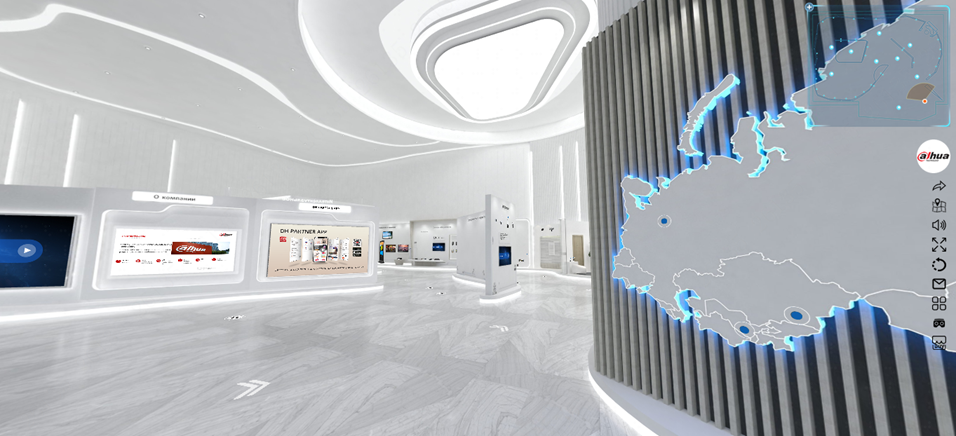What is Dahua Easy-to-Install PTZ Cameras ?
The PTZ product offers 2-in-1 bracket, quick-to-install structure and remote adjustment system. Dahua’s 2-in-1 bracket supports ceiling and wall mounting and reduces transportation and warehousing costs. The quick-to-install metal plate and fastener eliminate the need to disassemble the dome cover during the installation process, thus preventing water vapor from entering the device. In addition, the remote adjustment system enables remote adjustment of the camera for optimal monitoring range and enhanced work efficiency.

2-in-1 Bracket
As shown in the illustration below, the mounting port of the PTZ camera has two guide chutes, while the bracket have two guide bars for two directions.
Here are the steps for each installation method:
Wall Mounting. Connect the green guide bar to the guide chute of the camera and tighten the screws.
Ceiling Mounting. Connect the red guide bar to the guide chute of the camera and tighten the screws.
Quick-to-Install Structure
The main highlights are the quick installation of the metal plate and the top part of the PTZ camera equipped with buckle technology. These two components are fixed together through a buckle. This eliminates the need to disassemble the cover, thus reducing installation steps and avoiding water vapor from entering the device.
Remote Adjustment
After installing the PTZ camera, adjusting the camera angle is a must in order to obtain the optimal monitoring coverage. The Dahua PTZ cameras support remote adjustment of camera angles, covering a wider monitoring range of the scene and making it easier and convenient for operators to adjust the device without going on the site.
· Supports horizontal and vertical range adjustments to optimize the monitoring angle.
· Supports optical zoom to enhance the coverage of the monitoring range.

2-in-1 Bracket
As shown in the illustration below, the mounting port of the PTZ camera has two guide chutes, while the bracket have two guide bars for two directions.
Here are the steps for each installation method:
Wall Mounting. Connect the green guide bar to the guide chute of the camera and tighten the screws.
Ceiling Mounting. Connect the red guide bar to the guide chute of the camera and tighten the screws.
Quick-to-Install Structure
The main highlights are the quick installation of the metal plate and the top part of the PTZ camera equipped with buckle technology. These two components are fixed together through a buckle. This eliminates the need to disassemble the cover, thus reducing installation steps and avoiding water vapor from entering the device.
Remote Adjustment
After installing the PTZ camera, adjusting the camera angle is a must in order to obtain the optimal monitoring coverage. The Dahua PTZ cameras support remote adjustment of camera angles, covering a wider monitoring range of the scene and making it easier and convenient for operators to adjust the device without going on the site.
· Supports horizontal and vertical range adjustments to optimize the monitoring angle.
· Supports optical zoom to enhance the coverage of the monitoring range.

2-in-1 Bracket
As shown in the illustration below, the mounting port of the PTZ camera has two guide chutes, while the bracket have two guide bars for two directions.
Here are the steps for each installation method:
Wall Mounting. Connect the green guide bar to the guide chute of the camera and tighten the screws.
Ceiling Mounting. Connect the red guide bar to the guide chute of the camera and tighten the screws.
Quick-to-Install Structure
The main highlights are the quick installation of the metal plate and the top part of the PTZ camera equipped with buckle technology. These two components are fixed together through a buckle. This eliminates the need to disassemble the cover, thus reducing installation steps and avoiding water vapor from entering the device.
Remote Adjustment
After installing the PTZ camera, adjusting the camera angle is a must in order to obtain the optimal monitoring coverage. The Dahua PTZ cameras support remote adjustment of camera angles, covering a wider monitoring range of the scene and making it easier and convenient for operators to adjust the device without going on the site.
· Supports horizontal and vertical range adjustments to optimize the monitoring angle.
· Supports optical zoom to enhance the coverage of the monitoring range.

2-in-1 Bracket
As shown in the illustration below, the mounting port of the PTZ camera has two guide chutes, while the bracket have two guide bars for two directions.
Here are the steps for each installation method:
Wall Mounting. Connect the green guide bar to the guide chute of the camera and tighten the screws.
Ceiling Mounting. Connect the red guide bar to the guide chute of the camera and tighten the screws.
Quick-to-Install Structure
The main highlights are the quick installation of the metal plate and the top part of the PTZ camera equipped with buckle technology. These two components are fixed together through a buckle. This eliminates the need to disassemble the cover, thus reducing installation steps and avoiding water vapor from entering the device.
Remote Adjustment
After installing the PTZ camera, adjusting the camera angle is a must in order to obtain the optimal monitoring coverage. The Dahua PTZ cameras support remote adjustment of camera angles, covering a wider monitoring range of the scene and making it easier and convenient for operators to adjust the device without going on the site.
· Supports horizontal and vertical range adjustments to optimize the monitoring angle.
· Supports optical zoom to enhance the coverage of the monitoring range.

Recommend Products
Tipycal Scenarios

Retail
• The Quick-to-Install structure does not need to disassemble the cover, eliminating the risk of water vapor in the device.
• It provides a convenient way to install the dome camera and reduces installation steps.
Villa
• The 2-in-1 bracket supports both wall mounting and ceiling mounting. No need to purchase extra mount, thus reducing installation costs.
• The installer can directly install the camera, which significantly reduces installation workload.


















